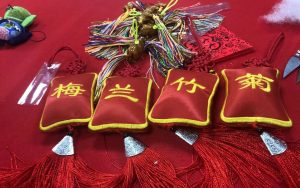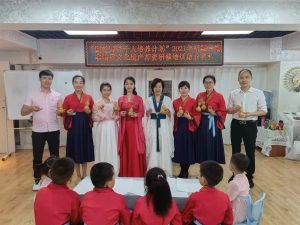Chinese yayue
Chinese yayue, commonly referred to as "yayue," is a system of music and dance used in conjunction with traditional Chinese rituals for the highest-ranking objects of worship. As a holistic and systematic concept, the notion of yayue encompasses various aspects such as systems, philosophies, content, forms, musical ensemble compositions, and occasions of use, extending beyond mere music. Yayue is a product of Liyue System(a kind of embodiment of Chinese culture, which is both a compendium of canons and rules and a guideline for people's various behaviors.). Liyue encompasses yayue, which is a vital component of the larger system of ritual music. Yayue holds national and societal symbolic significance within the realm of music, serving as a comprehensive expression of ritual culture. In early ancient China, what was initially referred to as "yue" often comprised a unified combination of singing, dancing, and instrumental music. Even as these elements evolved independently later on, yayue continued to echo this early concept.
Yayue, as the term implies, was primarily utilized in the traditional Chinese ritual system for "major state affairs" and sacrificial ceremonies, specifically auspicious rites. It embodied a strong hierarchical perspective, being exclusively performed for esteemed sacrificial recipients and used in accordance with the ritual system. This musical and dance system also participated in other crucial courtly ceremonies, emphasizing its role as a symbol of the nation. It represented the highest form of state music and dance, carrying more profound political and societal implications. Yayue originated from primitive ritual practices and the need for constructing a shared identity in ancient nation-states. Yayue constitutes a tangible embodiment of the spirit of ritual music, serving as a significant means for ancient people to comprehend the natural world and communicate with the divine and human realms. Consequently, yayue culture is an integral facet of the Chinese national spirit and cultural paradigm. Yayue civilization encapsulates the profound underlying logic of Chinese traditional cultural development, evolving from the collapse of ritual and music to their harmonious coexistence, adapting to specific historical contexts and accumulating increasingly rich cultural connotations, reflecting the developmental journey of Chinese ritual from its infancy to maturity, from individuality to universality, and from fragility to stability.
From a historical perspective, yayue's inception dates back to the Eastern Zhou period. In the "Book of Poetry," it is said, "With yayue and the southern wind, with bamboo pipes, there is no violation." Zheng Xuan's commentary interprets, "Yayue comprises myriad dances. 'Myriad,' 'southern,' and 'bamboo pipes' signify the three dance elements without transgression, denoting the concepts of progression and retreat." Due to the martial emphasis in Zhou-era music, myriad dances were called "yayue." Yayue represents the correct and harmonious aspect of music. The "Grand Dictionary of Chinese" defines "yayue" as "the dance music used in the ceremonies of emperors and kings of ancient times when they offered sacrifices to heaven and earth, to their ancestors, and on occasions of their court receptions and banquets. The Zhou dynasty used it for the six dances in their ancestral temple ceremonies. Confucianists considered its music 'right, harmonious, and peaceful,' and its lyrics 'elegant and pure.' It was highly regarded as the model of yayue. Each emperor of subsequent dynasties would establish his own yayue to praise the merits of his reign." The term "yayue" was initially recognized as national music in the "History of the Sui Dynasty." It states, "What is called 'national music' is termed 'yayue,' as the 'Preface to the Book of Songs' says, 'Speaking of matters in the world and representing the winds from the four directions, it is called yayue. Yayue means correctness.'" The "Ritual of the Great Tang Dynasty" inherited the legacy of the two Zhou dynasties, solidifying enduring concepts of ritual, and included Confucius as one of the recipients of "yayue" in sacrificial offerings, breaking the restriction that "yayue" was exclusively for court use. However, when Confucius was offered sacrifices in prefectures and counties, "yayue" was not allowed. From the Song Dynasty onward, as rulers elevated the veneration of Confucius, bestowing him with titles like the "Supreme Sage" and "King Wen," the state established Confucius temples in administrative entities above the county level. They introduced standardized "yayue" rituals, which have been passed down to the present.
Throughout history, China engaged in extensive intellectual and cultural exchanges with neighboring East Asian and Southeast Asian nations, such as Korea, South Korea, Japan, Vietnam, Singapore, Malaysia, and others. In the course of these enduring interactions, a "East Asian Confucian cultural sphere" emerged. Yayue, as a fundamental component of Chinese culture, particularly ritual culture, found wide dissemination within this East Asian Confucian cultural sphere, becoming an indispensable element in local ceremonial practices.
This comprehensive definition sheds light on the intricate historical, cultural, and philosophical dimensions of Chinese yayue, highlighting its multifaceted role in ancient Chinese society and its enduring influence in East Asia.



